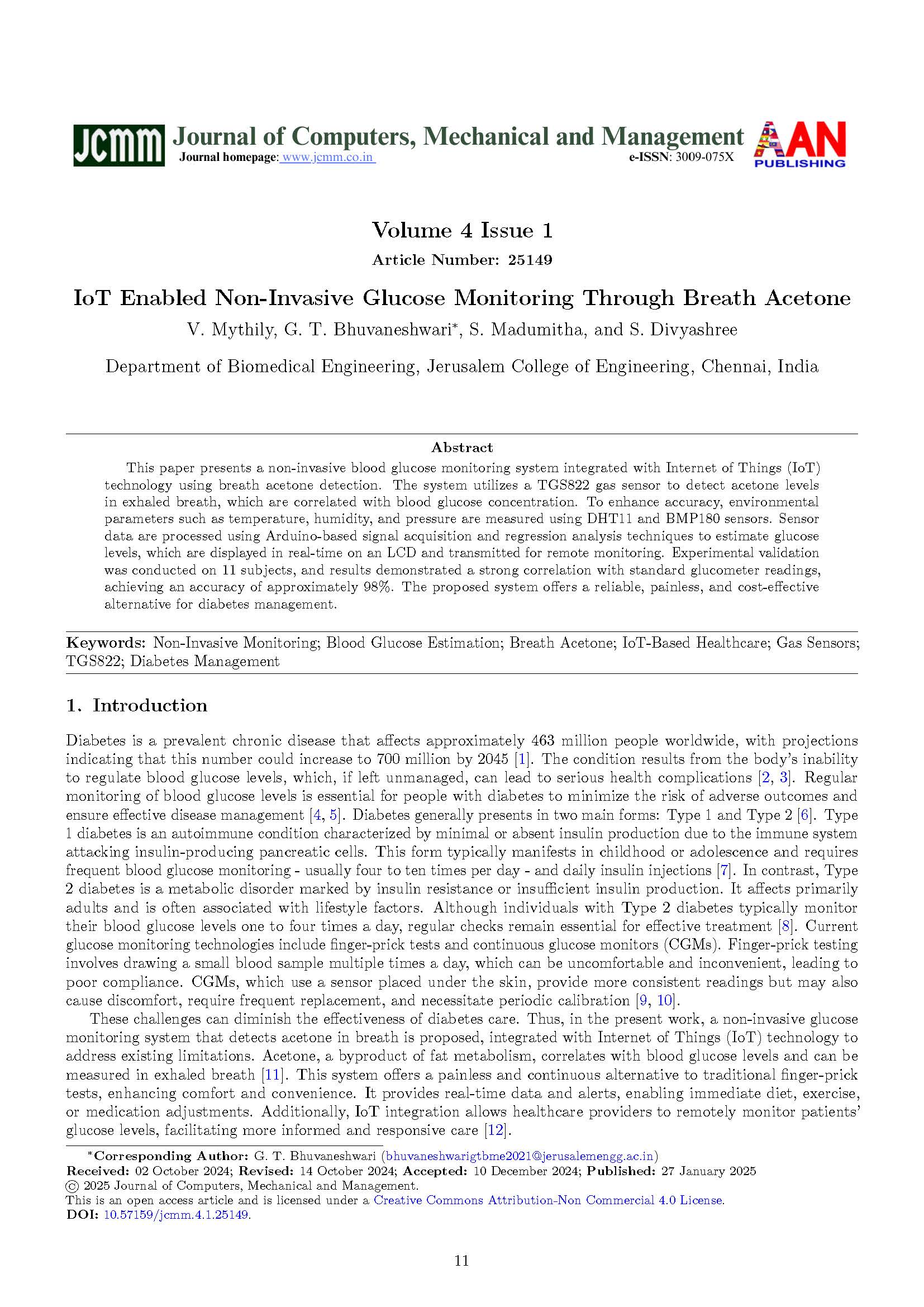IoT Enabled Non-Invasive Glucose Monitoring Through Breath Acetone
DOI:
https://doi.org/10.57159/jcmm.4.1.25149Keywords:
Non-Invasive Monitoring, Blood Glucose Estimation, Breath Acetone, IoT-Based Healthcare, Gas Sensors, TGS822, Diabetes ManagementAbstract
This paper presents a non-invasive blood glucose monitoring system integrated with Internet of Things (IoT) technology using breath acetone detection. The system utilizes a TGS822 gas sensor to detect acetone levels in exhaled breath, which are correlated with blood glucose concentration. To enhance accuracy, environmental parameters such as temperature, humidity, and pressure are measured using DHT11 and BMP180 sensors. Sensor data are processed using Arduino-based signal acquisition and regression analysis techniques to estimate glucose levels, which are displayed in real-time on an LCD and transmitted for remote monitoring. Experimental validation was conducted on 11 subjects, and results demonstrated a strong correlation with standard glucometer readings, achieving an accuracy of approximately 98%. The proposed system offers a reliable, painless, and cost-effective alternative for diabetes management.
References
A. Agarwal and V. V. Gossain, “Diabetes in the elderly,” Drugs in Diabetes, vol. 183, 2021.
M. Lotfy, J. Adeghate, H. Kalasz, J. Singh, and E. Adeghate, “Chronic complications of diabetes mellitus: a mini review,” Current Diabetes Reviews, vol. 13, no. 1, pp. 3–10, 2017.
A. Yachmaneni Jr, S. Jajoo, C. Mahakalkar, S. Kshirsagar, and S. Dhole, “A comprehensive review of the vascular consequences of diabetes in the lower extremities: current approaches to management and evaluation of clinical outcomes,” Cureus, vol. 15, no. 10, 2023.
G. Freckmann, S. Pleus, M. Grady, S. Setford, and B. Levy, “Measures of accuracy for continuous glucose monitoring and blood glucose monitoring devices,” Journal of Diabetes Science and Technology, vol. 13, no. 3, pp. 575–583, 2019.
G. Cappon, M. Vettoretti, G. Sparacino, and A. Facchinetti, “Continuous glucose monitoring sensors for diabetes management: a review of technologies and applications,” Diabetes & Metabolism Journal, vol. 43, no. 4, p. 383, 2019.
M. J. Redondo, W. A. Hagopian, R. Oram, A. K. Steck, K. Vehik, M. Weedon, A. Balasubramanyam, and D. Dabelea, “The clinical consequences of heterogeneity within and between different diabetes types,” Diabetologia, vol. 63, pp. 2040–2048, 2020.
J. M. Norris, R. K. Johnson, and L. C. Stene, “Type 1 diabetes—early life origins and changing epidemiology,” The Lancet Diabetes & Endocrinology, vol. 8, no. 3, pp. 226–238, 2020.
E. Ahmad, S. Lim, R. Lamptey, D. R. Webb, and M. J. Davies, “Type 2 diabetes,” The Lancet, vol. 400, no. 10365, pp. 1803–1820, 2022.
I. P. Smith, C. L. Whichello, J. Veldwijk, M. P. Rutten-van Mölken, C. G. Groothuis-Oudshoorn, R. C. Vos, E. W. de Bekker-Grob, and G. A. De Wit, “Diabetes patient preferences for glucose-monitoring technologies: results from a discrete choice experiment in Poland and the Netherlands,” BMJ Open Diabetes Research and Care, vol. 11, no. 1, p. e003025, 2023.
O. Didyuk, N. Econom, A. Guardia, K. Livingston, and U. Klueh, “Continuous glucose monitoring devices: past, present, and future focus on the history and evolution of technological innovation,” Journal of Diabetes Science and Technology, vol. 15, no. 3, pp. 676–683, 2021.
A. T. Güntner, I. C. Weber, S. Schon, S. E. Pratsinis, and P. A. Gerber, “Monitoring rapid metabolic changes in health and type-1 diabetes with breath acetone sensors,” Sensors and Actuators B: Chemical, vol. 367, p. 132182, 2022.
V. R. Boppana, “Role of IoT in remote patient monitoring systems,” Advances in Computer Sciences, vol. 2, no. 1, 2019.
L. Malinin, “Development of a non-invasive blood glucose monitor based on impedance measurements,” International Journal of Biomedical Engineering and Technology, vol. 8, no. 1, pp. 60–81, 2012.
J. Bold, Y. Cao, J. Louma, A. Rosen, and D. Sinkiewicz, “Non-invasive blood glucose monitor,” 2013.
A. Thati, A. Biswas, S. R. Chowdhury, and T. K. Sau, “Breath acetone-based non-invasive detection of blood glucose levels,” International Journal on Smart Sensing and Intelligent Systems, vol. 8, no. 2, p. 1244, 2015.
B. Gayathri, K. Sruthi, and K. U. Menon, “Non-invasive blood glucose monitoring using near infrared spectroscopy,” in 2017 International Conference on Communication and Signal Processing (ICCSP), pp. 1139–1142, IEEE, 2017.
B. E. Manurung, H. R. Munggaran, G. F. Ramadhan, and A. P. Koesoema, “Non-invasive blood glucose monitoring using near-infrared spectroscopy based on Internet of Things using machine learning,” in 2019 IEEE R10 Humanitarian Technology Conference (R10-HTC)(47129), pp. 5–11, IEEE, 2019.
H. Ali, F. Bensaali, and F. Jaber, “Novel approach to non-invasive blood glucose monitoring based on transmittance and refraction of visible laser light,” IEEE Access, vol. 5, pp. 9163–9174, 2017.
A. Sharma, W. S. AlGhamdi, H. Faber, Y.-H. Lin, C.-H. Liu, E.-K. Hsu, W.-Z. Lin, D. Naphade, S. Mandal, M. Heeney, et al., “Non-invasive, ultrasensitive detection of glucose in saliva using metal oxide transistors,” Biosensors and Bioelectronics, vol. 237, p. 115448, 2023.

Downloads
Published
How to Cite
Issue
Section
Categories
License
Copyright (c) 2025 Journal of Computers, Mechanical and Management

This work is licensed under a Creative Commons Attribution-NonCommercial 4.0 International License.
The Journal of Computers, Mechanical and Management applies the CC Attribution- Non-Commercial 4.0 International License to its published articles. While retaining copyright ownership of the content, the journal permits activities such as downloading, reusing, reprinting, modifying, distributing, and copying of the articles, as long as the original authors and source are appropriately cited. Proper attribution is ensured by citing the original publication.





